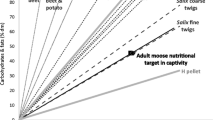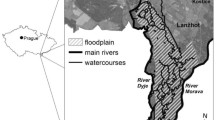Abstract
During recent decades, wild boar have successfully colonised areas previously believed to be unsuitable for the species. Estonia lies close to the northern limit of the species range, and mast foods, which are a common natural food source for many wild boar populations, are practically absent. We hypothesised that the proportion of cultivated area and especially supplementary feeding, which is widely used in Estonia to lower the winter mortality of game species, play important roles in sustaining the local wild boar population. To determine the most important factors shaping the abundance of wild boar in a northern environment, we developed mixed models to account for variation in an index of wild boar abundance (AI) based on winter track counts. The abundance of supplementary feeding sites and mean January temperature were the most important factors determining wild boar winter abundance. We conclude that the current high local population density is sustained by intensive supplementary feeding, which has exceeded the limiting effect of harsh winters.


Similar content being viewed by others
References
Acevedo P, Escudero MA, Muńoz R, Gortázar C (2006) Factors affecting wild boar abundance across an environmental gradient in Spain. Acta Theriol 51:327–336
Bieber C, Ruf T (2005) Population dynamics in wild boar Sus scrofa: ecology, elasticity of growth rate and implications for the management of pulsed resource consumers. J Appl Ecol 42:1203–1213
Boitani L, Trapanese P, Mattei L (1995) Demographic patterns of a wild boar (Sus scrofa L.) population in Tuscany, Italy. IBEX J Mt Ecol 3:197–201
Borowik T, Cornulier T, Jędrzejewska B (2013) Environmental factors shaping ungulate abundances in Poland. Acta Theriol 58:403–413
Calenge C, Maillard D, Fournier P, Fouque C (2004) Efficiency of spreading maize in the garrigues to reduce wild boar (Sus scrofa) damage to Mediterranean vineyards. Eur J Wildl Res 50:112–120
Cutini A, Chianucci F, Chirichella R, Donaggio E, Mattioli L, Apollonio M (2013) Mast seeding in deciduous forests of the northern Apennines (Italy) and its influence on wild boar population dynamics. Ann For Sci 70:493–502
Danilkin A (2001) The wild boar: an unprecedented spread or restoration of the species range? In. vol 1. Springer, pp 457–460
Fonseca C (2008) Winter habitat selection by wild boar Sus scrofa in southeastern Poland. Eur J Wildl Res 54:361–366
Fruzinski B (1995) Situation of wild boar populations in western Poland. IBEX J Mt Ecol 3:186–187
Fruziński B, Łabudzki L (2002) Management of wild boar in Poland. Z Jagdwiss 48:201–207
Geisser H, Reyer HU (2004) Efficacy of hunting, feeding, and fencing to reduce crop damage by wild boars. J Wildl Manag 68:939–946
Geisser H, Reyer HU (2005) The influence of food and temperature on population density of wild boar Sus scrofa in the Thurgau (Switzerland). J Zool 267:89–96
Honda T (2009) Environmental factors affecting the distribution of the wild boar, sika deer, Asiatic black bear and Japanese macaque in central Japan, with implications for human-wildlife conflict. Mamm Stud 34:107–116
Jędrzejewski W, Jędrzejewska B, Okarma H, Ruprecht AL (1992) Wolf predation and snow cover as mortality factors in the ungulate community of the Bialowieża National Park, Poland. Oecologia 90:27–36
Jezek M, Kušta T, Cerveny J (2013) Effect of supplementary feeding on spatial activity of wild boar during the winter season. In: Programme & Abstract Book 31st IUGB Congress. Brussels, p 219
Lemel J, Truve J, Söderberg B (2003) Variation in ranging and activity behaviour of European wild boar Sus scrofa in Sweden. Wildl Biol 9:29–36
Lindén H, Helle E, Helle P, Wikman M (1996) Wildlife triangle scheme in Finland: methods and aims for monitoring wildlife populations. Finn Game Res 49:4–11
Mattioli L, Capitani C, Gazzola A, Scandura M, Apollonio M (2011) Prey selection and dietary response by wolves in a high-density multi-species ungulate community. Eur J Wildl Res 57:909–922
Melis C, Szafrańska PA, Jędrzejewska B, Bartoń K (2006) Biogeographical variation in the population density of wild boar (Sus scrofa) in western Eurasia. J Biogeogr 33:803–811
Mexia-de-Almeida L, Santos P, Petrucci-Fonseca F (2004) Habitat selection by wild boar Sus scrofa L. In Alentejo, Portugal. Galemys: Boletín informativo de la Sociedad Española para la conservación y estudio de los mamíferos, pp 167–184
Navarro-Gonzalez N, Fernández-Llario P, Pérez E, Mentaberre G, López-Martín JM, Lavín S, Serrano E (2013) Supplemental feeding drives endoparasite infection in wild boar in Western Spain. Vet Parasitol 196:114–123
Neet C (1995) Population dynamics and management of Sus scrofa in western Switzerland: a statistical modelling approach. Ibex J Mt Ecol 3:188–191
Oja R (2012) Influence of supplementary feeding of wild boar (Sus scrofa) on groundnesting birds. Hirundo 25:34–46
Pinheiro J, Bates D, DebRoy S, Sarkar D, Core Team R (2011) nlme: linear and nonlinear mixed effects models. R package version 3. 1–102
Purger JJ, Meszaros LA (2006) Possible effects of nest predation on the breeding success of ferruginous ducks Aythya nyroca. Bird Conserv Int 16:309–316
R Core Team (2013) R: a language and environment for statistical computing. R Foundation for Statistical Computing, Vienna
Rosvold J, Andersen R (2008) Wild boar in Norway—is climate a limiting factor? Norges teknisk-naturvitenskapelige universitet Vitenskapsmuseet. Rapp Zool Ser 1:1–23
Rosvold J, Halley DJ, Hufthammer AK, Minagawa M, Andersen R (2010) The rise and fall of wild boar in a northern environment: evidence from stable isotopes and subfossil finds. The Holocene 20:1113–1121
Sachot S, Perrin N, Neet C (2003) Winter habitat selection by two sympatric forest grouse in western Switzerland: implications for conservation. Biol Conserv 112:373–382
Saniga M (2002) Nest loss and chick mortality in capercaillie (Tetrao urogallus) and hazel grouse (Bonasa bonasia) in West Carpathians. Folia Zool-Praha 51:205–214
Schley L, Dufrêne M, Krier A, Frantz AC (2008) Patterns of crop damage by wild boar (Sus scrofa) in Luxembourg over a 10-year period. Eur J Wildl Res 54:589–599
Süld K, Valdmann H, Laurimaa L, Soe E, Davison J, Saarma U (2014) An invasive vector of zoonotic disease sustained by anthropogenic resources: the raccoon dog in Northern Europe. PLoS One. doi:10.1371/journal.pone.0096358
Svobodová J, Koubová M, Mrštný L, Albrecht T, Kreisinger J (2012) Temporal variation in nest predation risk along habitat edges between grassland and secondary forest in Central Europe. Eur J Wildl Res 58:315–323
Thurfjell H, Ball JP, Åhlén P-A, Kornacher P, Dettki H, Sjöberg K (2009) Habitat use and spatial patterns of wild boar Sus scrofa (L.): agricultural fields and edges. Eur J Wildl Res 55:517–523
Valdmann H, Koppa O, Looga A (1998) Diet and prey selectivity of wolf Canis lupus in middle-and south-eastern Estonia. Balt For 4:42–46
Valdmann H, Andersone-Lilley Z, Koppa O, Ozolins J, Bagrade G (2005) Winter diets of wolf Canis lupus and lynx Lynx lynx in Estonia and Latvia. Acta Theriol 50:521–527
Vulla E, Hobson KA, Korsten M, Leht M, Martin A-J, Lind A, Männil P, Valdmann H, Saarma U (2009) Carnivory is positively correlated with latitude among omnivorous mammals: evidence from brown bears, badgers and pine martens. Ann Zool Fenn 6:395–415
Acknowledgments
This work was supported by the Estonian Research Council (grant IUT-2032). We are grateful to the Estonian Meteorological and Hydrological Institute for providing climate data. We also thank Jaanus Remm for helping to create Fig. 1 and John Davison for proofreading the manuscript and providing useful comments.
Author information
Authors and Affiliations
Corresponding author
Additional information
Communicated by: Dries Kuijper
Rights and permissions
About this article
Cite this article
Oja, R., Kaasik, A. & Valdmann, H. Winter severity or supplementary feeding—which matters more for wild boar?. Acta Theriol 59, 553–559 (2014). https://doi.org/10.1007/s13364-014-0190-0
Received:
Accepted:
Published:
Issue Date:
DOI: https://doi.org/10.1007/s13364-014-0190-0




